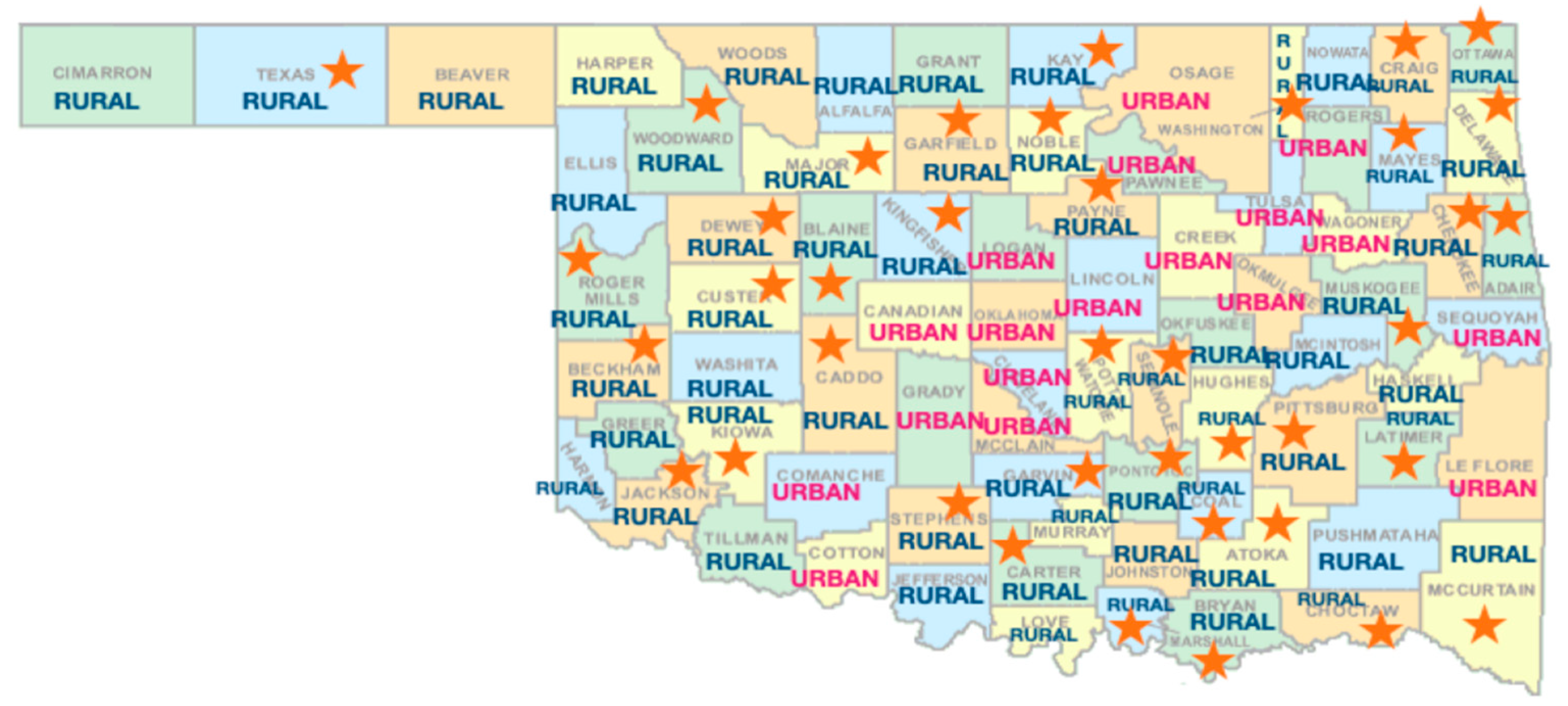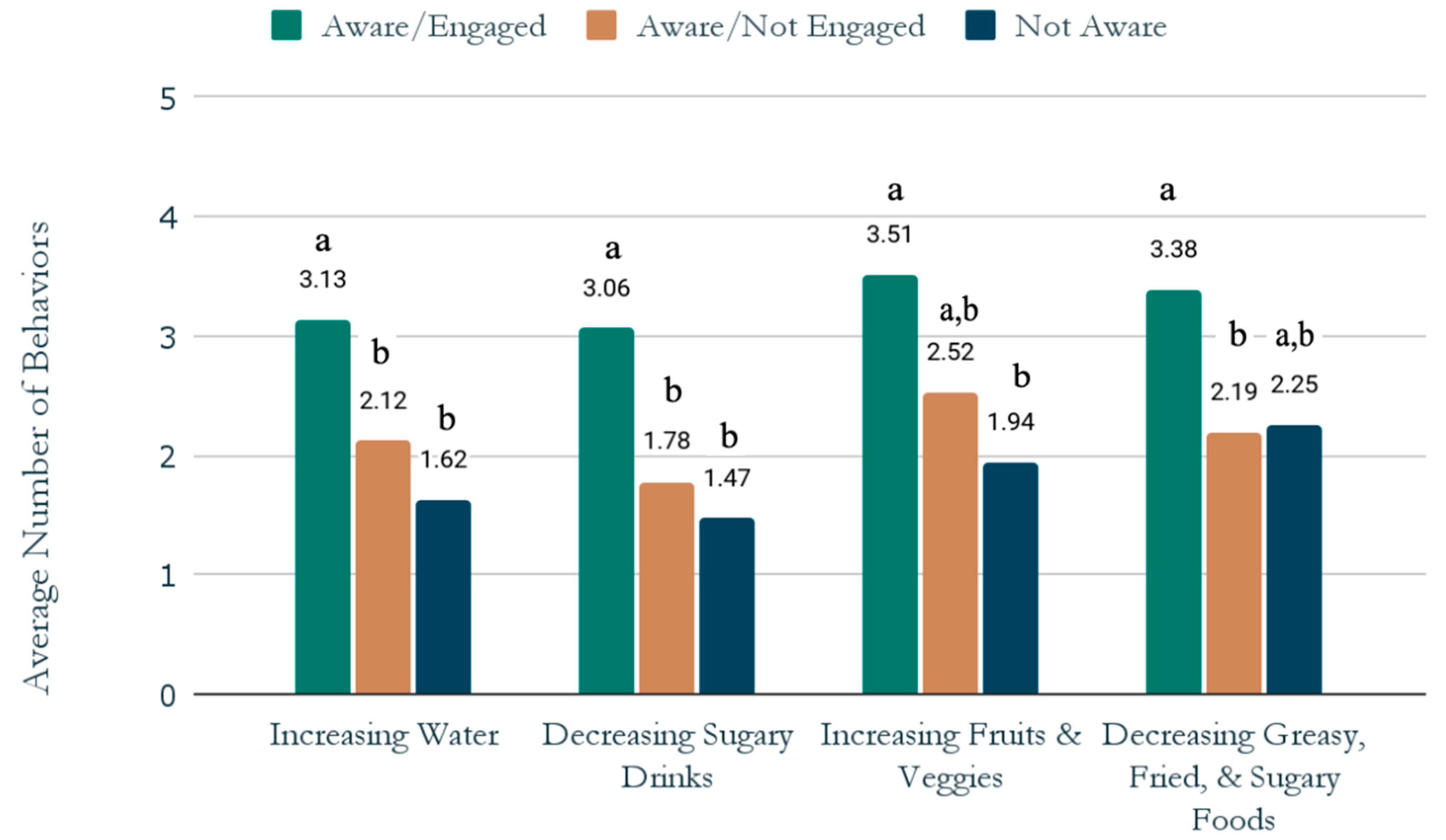Swap Up Your Meal: A Mass Media Nutrition Education Campaign for Oklahoma Teens
Abstract
:1. Introduction
1.1. Mass Media Obesity Prevention
1.2. Fast Food and Sugary Drink Marketing
1.3. The SAVI Framework
1.4. Oklahoma’s Swap Up Campaign for Teens
1.5. Current Study
2. Materials and Methods
2.1. Campaign Intervention
2.2. Design and Procedures
2.3. Measures
2.4. Data Analysis
3. Results
3.1. Demographics
3.2. Campaign Delivery, Engagement, and Relevance
3.3. Nutrition-Related Behaviors
3.4. Do Message Awareness and Perceived Relevance Differ by Campaign Awareness and Engagement?
3.5. Do Self-Reported Nutrition-Related Behaviors Differ by Campaign Awareness and Engagement?
4. Discussion
4.1. Summary of Findings
4.2. SAVI Messaging
4.3. Limitations and Future Research
4.4. Conclusions
Supplementary Materials
Author Contributions
Funding
Institutional Review Board Statement
Informed Consent Statement
Data Availability Statement
Acknowledgments
Conflicts of Interest
References
- Centers for Disease Control and Prevention (CDC). Department of Health and Human Services, Centers for Disease Control and Prevention; Behavioral Risk Factor Surveillance System Survey Data: Atlanta, GA, USA, 2021. [Google Scholar]
- Warren, M.; Beck, S.; Delgado, D. The State of Obesity. 2020. Available online: https://www.tfah.org/wp-content/uploads/2020/09/TFAHObesityReport_20.pdf (accessed on 24 January 2022).
- Hollar, D.; Messiah, S.E.; Lopez-Mitnik, G.; Hollar, T.L.; Almon, M.; Agatston, A.S. Effect of a two-year obesity prevention intervention on percentile changes in body mass index and academic performance in low-income elementary school children. Am. J. Public Health 2010, 100, 646–653. [Google Scholar] [CrossRef] [PubMed]
- Steele, C.B.; Thomas, C.C.; Henley, S.J.; Massetti, G.M.; Galuska, D.A.; Agurs-Collins, T.; Puckett, M.; Richardson, L.C. Vital Signs: Trends in Incidence of Cancers Associated with Overweight and Obesity—United States, 2005–2014. MMWR Morb. Mortal. Wkly. Rep. 2017, 66, 1052–1058. [Google Scholar] [CrossRef] [PubMed]
- Singh, A.S.; Mulder, C.; Twisk, J.W.; Van Mechelen, W.; Chinapaw, M.J. Tracking of childhood overweight into adulthood: A systematic review of the literature. Obes. Rev. 2008, 9, 474–488. [Google Scholar] [CrossRef] [PubMed]
- The Child and Adolescent Health Measurement Initiative. Title V National Outcome Measure #20: Percent of Adolescents, Ages 10 through 17, Who Are Obese (BMI at or above the 95th Percentile). Data Resource Center for Child & Adolescent Health. Available online: https://www.childhealthdata.org/browse/rankings/maps?s=251 (accessed on 25 March 2022).
- Centers for Disease Control and Prevention. 2019 Oklahoma Youth Risk Behavior Survey (YRBS). Available online: www.cdc.gov/YRBSS (accessed on 10 June 2022).
- Blanchard, T.C.; Matthews, T.L. Retail concentration, food deserts, and food-disadvantaged communities in rural America. Remaking N. Am. Food Syst. Strateg. Sustain. 2007, 201–215. [Google Scholar]
- Oklahoma Policy Institute. Census Data Show Oklahoma Still Lags Nation in Poverty Rate. Available online: https://okpolicy.org/census-data-shows-oklahoma-still-lags-nation-in-poverty-rate/ (accessed on 18 March 2022).
- Carter, M.A.; Dubois, L. Neighborhoods and child adiposity: A critical appraisal of the literature. Health Place 2010, 16, 616–628. [Google Scholar] [CrossRef]
- Finkelstein, E.A.; Strombotne, K.L. The economics of obesity. Am. J. Clin. Nutr. 2010, 91, 1520S–1524S. [Google Scholar] [CrossRef]
- Brownell, K.D.; Farley, T.; Willett, W.C.; Popkin, B.M.; Chaloupka, F.J.; Thompson, J.W.; Ludwig, D.S. The public health and economic benefits of taxing sugar-sweetened beverages. N. Engl. J. Med. 2009, 361, 1599–1605. [Google Scholar] [CrossRef]
- Tyler, J. These States Have the Highest Concentration of Fast-Food Restaurants in America. Business Insider. Available online: https://www.businessinsider.com/states-with-most-fast-food-restaurants-per-capita-2018-6 (accessed on 24 January 2022).
- Datafiniti. Ranking Cities With the Most and Least Fast Food Restaurants 2018. Available online: https://datafiniti.co/fast-food-restaurants-america/ (accessed on 24 January 2022).
- United States Census Bureau, 2021. 2020 Household Pulse Survey. Available online: https://www.census.gov/programs-surveys/household-pulse-survey/data.html (accessed on 25 March 2022).
- Baranowski, T.; Mendlein, J.; Resnicow, K.; Frank, E.; Cullen, K.W.; Baranowski, J. Physical activity and nutrition in children and youth: An overview of Obesity Prevention. Prev. Med. 2000, 31, S1–S10. [Google Scholar] [CrossRef]
- Fruh, S.; Williams, S.; Hayes, K.; Hauff, C.; Hudson, G.M.; Sittig, S.; Graves, R.J.; Hall, H.; Barinas, J. A practical approach to obesity prevention: Healthy Home Habits. J. Am. Assoc. Nurse Pract. 2021, 33, 1055–1065. [Google Scholar] [CrossRef]
- Black, A.P.; D’Onise, K.; McDermott, R.; Vally, H.; O’Dea, K. How effective are family-based and institutional nutrition interventions in improving children’s diet and health? A systematic review. BMC Public Health 2017, 17, 818. [Google Scholar] [CrossRef]
- Centers for Disease Control and Prevention. CDC Healthy Schools: Promoting Healthy Behaviors. Healthy Behaviors. Available online: https://www.cdc.gov/healthyschools/healthybehaviors.htm (accessed on 29 April 2022).
- Doak, C.M.; Visscher, T.L.S.; Renders, C.M.; Seidell, J.C. The prevention of overweight and obesity in children and adolescents: A review of interventions and programmes. Obes. Rev. 2006, 7, 111–136. [Google Scholar] [CrossRef] [PubMed]
- Evans, A.E.; Dave, J.; Tanner, A.; Duhe, S.; Condrasky, M.; Wilson, D.; Griffin, S.; Palmer, M.; Evans, M. Changing the Home Nutrition Environment. Fam. Community Health 2006, 29, 43–54. [Google Scholar] [CrossRef] [PubMed]
- Summerbell, C.D.; Waters, E.; Edmunds, L.; Kelly, S.A.M.; Brown, T.; Campbell, K.J. Interventions for preventing obesity in children. Cochrane Database Syst. Rev. 2005. [Google Scholar] [CrossRef]
- World Health Organization. Population-Based Approaches to Childhood Obesity Prevention. WHO Library. Available online: https://apps.who.int/iris/bitstream/handle/10665/80149/9789241504782_eng.pdf (accessed on 29 April 2022).
- Englund, T.R.; Zhou, M.; Hedrick, V.E.; Kraak, V.I. How branded marketing and media campaigns can support a healthy diet and food well-being for Americans: Evidence for 13 campaigns in the United States. J. Nutr. Educ. Behav. 2020, 52, 87–95. [Google Scholar] [CrossRef]
- Robinson, M.N.; Tansil, K.A.; Elder, R.W.; Soler, R.E.; Labre, M.P.; Mercer, S.L.; Eroglu, D.; Baur, C.; Lyon-Daniel, K.; Fridinger, F.; et al. Mass media health communication campaigns combined with health-related product distribution: A community guide systematic review. Am. J. Prev. Med. 2014, 47, 360–371. [Google Scholar] [CrossRef]
- Huhman, M.E.; Potter, L.D.; Nolin, M.J.; Piesse, A.; Judkins, D.R.; Banspach, S.W.; Wong, F.L. The Influence of the VERB campaign on children’s physical activity in 2002 to 2006. Am. J. Public Health 2010, 100, 638–645. [Google Scholar] [CrossRef]
- Wong, F.; Huhman, M.; Heitzler, C.; Asbury, L.; Bretthauer-Mueller, R.; McCarthy, S.; Londe, P. VERB—A social marketing campaign to increase physical activity among youth. Prev. Chronic Dis. 2004, 1, A10. [Google Scholar]
- Evans, W.D.; Christoffel, K.K.; Necheles, J.W.; Becker, A.B. Social marketing as a childhood obesity prevention strategy. Obesity 2010, 18, S23–S26. [Google Scholar] [CrossRef]
- Taj, F.; Klein, M.C.; van Halteren, A. Digital health behavior change technology: Bibliometric and scoping review of two decades of research. JMIR mHealth uHealth 2019, 7, e13311. [Google Scholar] [CrossRef]
- Anderson, M.; Jiang, J. Teens, social media & technology 2018. Pew Res. Cent. 2018, 31, 1673–1689. [Google Scholar]
- Pew Research Center, 2021. Social Media Use in 2021. Available online: https://www.pewresearch.org/internet/wp-content/uploads/sites/9/2021/04/PI_2021.04.07_Social-Media-Use_FINAL.pdf (accessed on 11 April 2022).
- Twenge, J.M.; Martin, G.N.; Spitzberg, B.H. Trends in U.S. Adolescents’ media use, 1976–2016: The rise of digital media, the decline of TV, and the (near) demise of print. Psychol. Pop. Media Cult. 2019, 8, 329–345. [Google Scholar] [CrossRef]
- Davis, K.C.; Shafer, P.R.; Rodes, R.; Kim, A.; Hansen, H.; Patel, D.; Coln, C.; Beistle, D. Does digital video advertising increase population-level reach of multimedia campaigns? Evidence from the 2013 tips from former smokers campaign. J. Med. Internet Res. 2016, 18, e5683. [Google Scholar] [CrossRef]
- Evans, W.D.; Abroms, L.C.; Broniatowski, D.; Napolitano, M.A.; Arnold, J.; Ichimiya, M.; Agha, S. Digital Media for Behavior Change: Review of an Emerging Field of Study. Int. J. Environ. Res. Public Health 2022, 19, 9129. [Google Scholar] [CrossRef] [PubMed]
- Romberg, A.R.; Bennett, M.; Tulsiani, S.; Simard, B.; Kreslake, J.M.; Favatas, D.; Vallone, D.M.; Hair, E.C. Validating self-reported ad recall as a measure of exposure to digital advertising: An exploratory analysis using ad tracking methodology. Int. J. Environ. Res. Public Health 2020, 17, 2185. [Google Scholar] [CrossRef] [PubMed]
- Guillory, J.; Crankshaw, E.; Farrelly, M.C.; Alam, I.; Fiacco, L.; Curry, L.; Hoffman, F.; Ganz, O.; Delahanty, J. LGBT young adults’ awareness of and receptivity to the This Free Life tobacco public education campaign. Tob. Control 2021, 30, 63–70. [Google Scholar] [CrossRef]
- Kostygina, G.; Tran, H.; Binns, S.; Szczypka, G.; Emery, S.; Vallone, D.; Hair, E. Boosting health campaign reach and engagement through use of social media influencers and memes. Soc. Media Soc. 2020, 6, 205630512091247. [Google Scholar] [CrossRef]
- Padez, C.M.P.; Nogueira, H.G.D.S.M. Describing studies on childhood obesity determinants by Socio-Ecological Model level: A scoping review to identify gaps and provide guidance for future research. Int. J. Obes. 2019, 43, 1883–1890. [Google Scholar]
- Cassidy, O.; Shin, H.W.; Song, E.; Jiang, E.; Harri, R.; Cano, C.; Vedanthan, R.; Ogedegbe, G.; Bragg, M. Comparing McDonald’s Food Marketing practices on official Instagram accounts across 15 countries. BMJ Nutr. Prev. Health 2021, 4, 510–518. [Google Scholar] [CrossRef]
- Robinson, T.N.; Banda, J.A.; Hale, L.; Lu, A.S.; Fleming-Milici, F.; Calvert, S.L.; Wartella, E. Screen Media Exposure and Obesity in Children and Adolescents. Pediatrics 2017, 140 (Suppl. S2), S97–S101. [Google Scholar] [CrossRef]
- Kelly, B.; King-MPsy, L.; Chapman-Mnd, K.; Boyland, E.; Bauman, A.E.; Baur, L.A. A hierarchy of unhealthy food promotion effects: Identifying methodological approaches and knowledge gaps. Am. J. Public Health 2015, 105, e86–e95. [Google Scholar] [CrossRef]
- Center for Science in the Public Interest. Nearly 70% of Food Ads on Nickelodeon are for Junk. CSPINET. Available online: https://www.cspinet.org/new/201303211.html (accessed on 10 February 2022).
- West, H. Big Gulp: The Problem of Sugary Drinks and Children. Available online: https://salud-america.org/childrens-drinks-facts-2019/ (accessed on 10 February 2022).
- Piernas, C.; Popkin, B.M. Trends in snacking among U.S. children. Health Aff. 2010, 29, 398–404. [Google Scholar] [CrossRef] [PubMed]
- Adhikari, C.; Puri, A.; Thapa, D.; Thapa, R.; Magar, S.; Sunil, G.C. Application of Social Cognitive Theory in obesity prevention: A rapid review. J. Health Allied Sci. 2018, 7, 53–62. [Google Scholar] [CrossRef]
- Bagherniya, M.; Taghipour, A.; Sharma, M.; Sahebkar, A.; Contento, I.R.; Keshavarz, S.A.; Darani, F.M.; Safarian, M. Obesity intervention programs among adolescents using social cognitive theory: A systematic literature review. Health Educ. Res. 2018, 33, 26–39. [Google Scholar] [CrossRef]
- Beckerley, S.; Jordan, J. Branding for People Not Topics: What public health nutrition can learn from commercial marketing. Sight Life Mag. 2020, 34, 75–79. [Google Scholar]
- McAlaney, J.; Bewick, B.; Hughes, C. The international development of the ‘Social Norms’ approach to drug education and prevention. Drugs Educ. Prev. Policy 2011, 18, 81–89. [Google Scholar] [CrossRef]
- Wang, Y.; Xue, H.; Chen, H.J.; Igusa, T. Examining social norm impacts on obesity and eating behaviors among US school children based on agent-based model. BMC Public Health 2014, 14, 1–11. [Google Scholar] [CrossRef] [PubMed]
- Lally, P.; Bartle, N.; Wardle, J. Social norms and diet in adolescents. Appetite 2011, 57, 623–627. [Google Scholar] [CrossRef]
- Perkins, J.M.; Perkins, H.W.; Craig, D.W. Peer weight norm misperception as a risk factor for being over and underweight among UK secondary school students. Eur. J. Clin. Nutr. 2010, 64, 965–971. [Google Scholar] [CrossRef]
- Mahr, R.; Ott, L. Oklahoma Tobacco Settlement Endowment Trust Online Tracker Benchmark Report; Rescue Agency: San Diego, CA, USA, 2020; Unpublished work. [Google Scholar]
- Fernandez; Redke; Lopez. Oklahoma Tobacco Settlement Endowment Trust Message Testing Research Report; Rescue Agency: San Diego, CA, USA, 2020; Unpublished work. [Google Scholar]
- US Cities List. The Most Comprehensive Database of U.S. Cities. Complete List of All U.S. Cities. Available online: https://www.uscitieslist.org/ (accessed on 25 February 2022).
- United States Census Bureau. 2021 Estimates: Oklahoma Quick Facts. Available online: https://www.census.gov/quickfacts/OK (accessed on 10 June 2022).
- Petty, R.E.; Priester, J.R.; Briñol, P. Media effects: Advances in theory and research. In Mass Media Attitude Change: Implications of the Elaboration Likelihood Model of Persuasion; Bryant, J., Zillmann, D., Eds.; Lawrence Erlbaum Associates Publishers: Mahwah, NJ, USA, 2002; pp. 155–198. [Google Scholar]
- Chung, A.; Vieira, D.; Donley, T.; Tan, N.; Jean-Louis, G.; Gouley, K.K.; Seixas, A. Adolescent peer influence on eating behaviors via social media: Scoping review. J. Med. Internet Res. 2021, 23, e19697. [Google Scholar] [CrossRef]
- Krishnan, A.; Zhou, X. Modeling the effect of health antecedents and social media engagement on healthy eating and quality of life. J. Appl. Commun. Res. 2019, 47, 365–380. [Google Scholar] [CrossRef]
- Yardley, L.; Spring, B.J.; Riper, H.; Morrison, L.G.; Crane, D.H.; Curtis, K.; Merchant, G.C.; Naughton, F.; Blandford, A. Understanding and promoting effective engagement with digital behavior change interventions. Am. J. Prev. Med. 2016, 51, 833–842. [Google Scholar] [CrossRef] [PubMed]
- Jordan, I.; Keding, G.B.; Stosius, L.; Hawrysz, I.; Janiszewska, K.; Heil, E.A. Changes in vegetable consumption in times of COVID-19—First findings from an international civil science project. Front. Nutr. 2021, 8, 686786. [Google Scholar] [CrossRef] [PubMed]
- Litton, M.M.; Beavers, A.W. The Relationship between Food Security Status and Fruit and Vegetable Intake during the COVID-19 Pandemic. Nutrients 2021, 13, 712. [Google Scholar] [CrossRef] [PubMed]



| SAVI Component | Description | Swap Up Application |
|---|---|---|
| Specific | Must include a specific example of what the audience can do to change their behavior | When you go to the gas station for breakfast, get a low-fat and low-sugar yogurt and a banana instead of a donut. |
| Acceptable | Must be acceptable within the cultural, familial, and social contexts of the audience’s lives | Swap fizzy water for fountain soda at a fast food restaurant (instead of “Don’t eat at fast food restaurants or convenience stores”). |
| Viable | Must be realistic within the constraints of our audience’s available time, budget and skills | Do not expect a teen to be able to revamp their family meals or overhaul their diet and instead focus on a reasonable individual action they can control, like what they buy outside of the home and what is within their budget. |
| Impactful | If adopted, the message would cause a meaningful impact on the audience’s nutrition | Pick a side of carrots instead of fries (this is impactful because fast food is a daily occurrence). |
| Asset | Media Type | Audience | Main Message | Media Flighting |
|---|---|---|---|---|
 Fuel for Football https://www.youtube.com/watch?v=99Ks8sG4dng accessed on 31 May 2022 | :30 video ad | Statewide | Swap a slushie for water; sugar slows you down and causes crashes/water energizes you | February–March 2021 |
 Sluggish https://www.youtube.com/watch?v=1u-pjQI9NyQhttps://youtu.be/ONDIIPbUxKI accessed on 31 May 2022 | :30 video ad | Urban | Swap chips for apples and peanut butter; greasy foods slow you down/protein gives you energy | May–June 2021 |
 Blank-Minded https://www.youtube.com/watch?v=IlgYwdg0DCg accessed on 31 May 2022 | :30 video ad | Rural | Swap a milkshake for water; sugar slows you down/water refreshes you | May–June 2021 |
 How Food Affects You | Interactive website/ game | Statewide | Greasy foods slow you down; sugar causes crashes | February 2021–current |
 Dynamic Duo https://www.instagram.com/p/CU8raPQNnxf/?utm_medium=copy_link accessed on 31 May 2022 | :15 digital video | Statewide | Fruits and vegetables give you energy; swap fried foods for a salad | October–December 2021 |
 Snacking Tips https://www.instagram.com/swapupok/ accessed on 31 May 2022 | GIF | Statewide | Nutrient-packed snacks will fill you up | October–December 2021 |
| Variable | Total Sample % (n) |
|---|---|
| Total | 200 |
| Female | 70% (140) |
| Age | 16.8 (SD = 1.4) |
| 13 years old | 2% (4) |
| 14 years old | 6% (11) |
| 15 years old | 9% (18) |
| 16 years old | 22% (44) |
| 17 years old | 24% (48) |
| 18 years old | 33% (66) |
| 19 years old | 4% * (9) |
| Race/ethnicity | |
| Hispanic | 11% (21) |
| Non-Hispanic White | 59% (118) |
| Non-Hispanic Black | 7% (14) |
| Non-Hispanic Asian/Pacific Islander | 2% (7) |
| Non-Hispanic American Indian/Native American | 9% (17) |
| Non-Hispanic other or 2 or more races | 12% (23) |
| County (Urban) | 71% (142) |
| Obesity Risk (Overweight) | 44% (87) |
Publisher’s Note: MDPI stays neutral with regard to jurisdictional claims in published maps and institutional affiliations. |
© 2022 by the authors. Licensee MDPI, Basel, Switzerland. This article is an open access article distributed under the terms and conditions of the Creative Commons Attribution (CC BY) license (https://creativecommons.org/licenses/by/4.0/).
Share and Cite
Wagner, D.E.; Seneres, G.; Jones, E.; Brodersen, K.A.; Whitsitt-Paulson, S. Swap Up Your Meal: A Mass Media Nutrition Education Campaign for Oklahoma Teens. Int. J. Environ. Res. Public Health 2022, 19, 10110. https://doi.org/10.3390/ijerph191610110
Wagner DE, Seneres G, Jones E, Brodersen KA, Whitsitt-Paulson S. Swap Up Your Meal: A Mass Media Nutrition Education Campaign for Oklahoma Teens. International Journal of Environmental Research and Public Health. 2022; 19(16):10110. https://doi.org/10.3390/ijerph191610110
Chicago/Turabian StyleWagner, Dana E., Gabrielle Seneres, Elisabeth Jones, Kelli A. Brodersen, and Sjonna Whitsitt-Paulson. 2022. "Swap Up Your Meal: A Mass Media Nutrition Education Campaign for Oklahoma Teens" International Journal of Environmental Research and Public Health 19, no. 16: 10110. https://doi.org/10.3390/ijerph191610110
APA StyleWagner, D. E., Seneres, G., Jones, E., Brodersen, K. A., & Whitsitt-Paulson, S. (2022). Swap Up Your Meal: A Mass Media Nutrition Education Campaign for Oklahoma Teens. International Journal of Environmental Research and Public Health, 19(16), 10110. https://doi.org/10.3390/ijerph191610110






